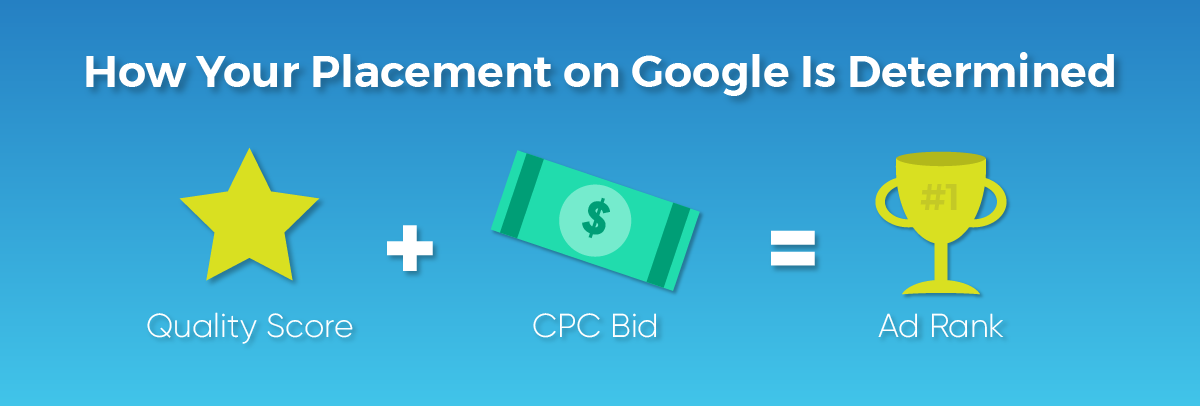How To Increase Your Google Quality Score
In my previous blog titled “AdWords Bidding Strategies – What Your Competitors May Not Know,” we covered bidding strategy and the key role it plays in your Ad Rank in Google AdWords. The other major factor in Ad Rank is Quality Score, which we’ll take a look at more in depth. Quality score is deemed by Google, but as the account manager you have a lot of influence in the grade. In this post, we’ll cover why Google’s Quality Score is important, the three major components that go into the score, and how you can increase that score through optimizing your ads and website to meet Google’s standards.

Why Quality Score Matters
The quality of your ad and landing page plays a key role in determining your Ad Rank each time an auction is run for a searcher’s query. Though Google does not directly use the Quality Score you see in AdWords, the score gives you an approximation of the overall quality of your ad and landing page. AdWords breaks this down into a few components (that we’ll take a look at in the next section) and gives you specific grades that you can look to improve upon.
By improving your overall Quality Score, you can often directly lower the cost of each click you pay for in AdWords. This can lead to some big savings for high volume keywords. If you can bump up your Quality Score from 5 to say, 8 or 9 for one of your higher volume keywords, it could mean the difference between a campaign being unfeasible or highly profitable.
The specific factors that go into this overall score of 1-10 include: Expected Click-Through-Rate (CTR), Ad Relevance, and Landing Page Experience. Google has also added these as separate columns you can add to your customized view when analyzing the keywords in your campaigns.
The Components of Quality Score
Ad Relevance
The grade assigned to this category is going to be an indication of how closely related your keywords are to the ads that will display in that ad group. There are three separate grades that can be given to the different components of quality score: above average, average, or below average. If the assigned grade is not “above average”, there is likely some opportunity to improve your quality score through this component.
There are some important things to consider when trying to ensure you maintain a good ad relevance score. First, you want to make sure your ad groups are tightly grouped around very similar keywords. This will make it much easier to build ads around them. If an ad group has five completely different keywords, for example, it is going to be very difficult to create an ad that is relevant to all five keywords. Make sure the keyword is in the ad copy (preferably early in the ad as that will also help with CTRs etc.) and it is also a good idea to have it in the Display URL as well.

As a general guideline, just build an ad that would be a relevant, valuable message to someone searching for the specific keywords in the ad group. This will usually give you the average or above average grade you are looking for.
Expected Click-Through-Rate
This is a grade given by Google that is based on the keyword’s past performance considering its ad position. In other words, raising your bid will not directly give you a higher score here, according to Google. A good way to ensure your keywords are generating solid CTRs would be to make highly relevant ads, as outlined above, and add negative keywords to ensure you are not showing up for any irrelevant search terms. Experimenting with different call to actions and doing some split testing between ads are some great ways to improve CTRs across the account in general.
Landing Page Experience
This component can be quite interesting to tackle if the grade is not “above average” and there is some room for improvement. The reason being that, unless you have other landing pages to direct the ads to that might be relevant and more appealing to searchers, there is probably going to be some development or design work involved.
A landing page might just need some simple tweaks, like adding in the keywords to an H1 and some of the content etc., or it may need a complete overhaul and redesign. Having access to the site and/or working with a web designer is usually necessary to make significant changes to the landing page experience across your AdWords account.
Making significant changes to your landing page is generally not only beneficial to your quality score, but it can also have a major impact on your conversions. Making key changes that improve your conversion rate from your traffic in AdWords is the main goal here anyway, as the main reason you are looking to improve Quality Score is to lower CPCs and consequently CPAs (cost-per-acquisition).
Conclusion
As an account manager, anything you can do to lower CPC is going to go a long way toward making your campaigns profitable. Accomplishing that while maintaining position and impressions is not always easy. Though some factors, like competition, you don’t have control over, Quality Score is part of the CPC equation you can have a significant impact on.
In this post, we covered why Quality Score is important in the Ad Rank equation and outlined the three components that make up Quality Score. Making improvements to these components and working towards the above average grade for each can help you reach your CPC goals and boost overall ROI for your AdWords campaigns.
To learn more about Quality Score and how it affects your advertising on Google AdWords, you can reach out to us here.
Ready To Grow?
Let's Talk!


